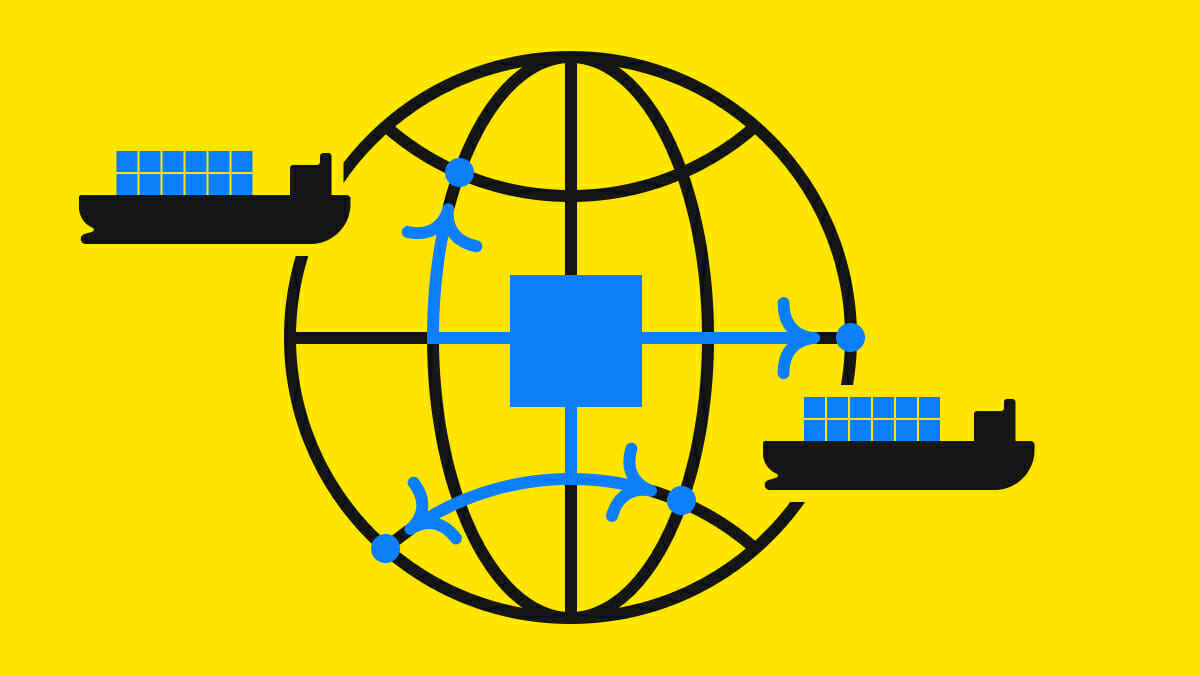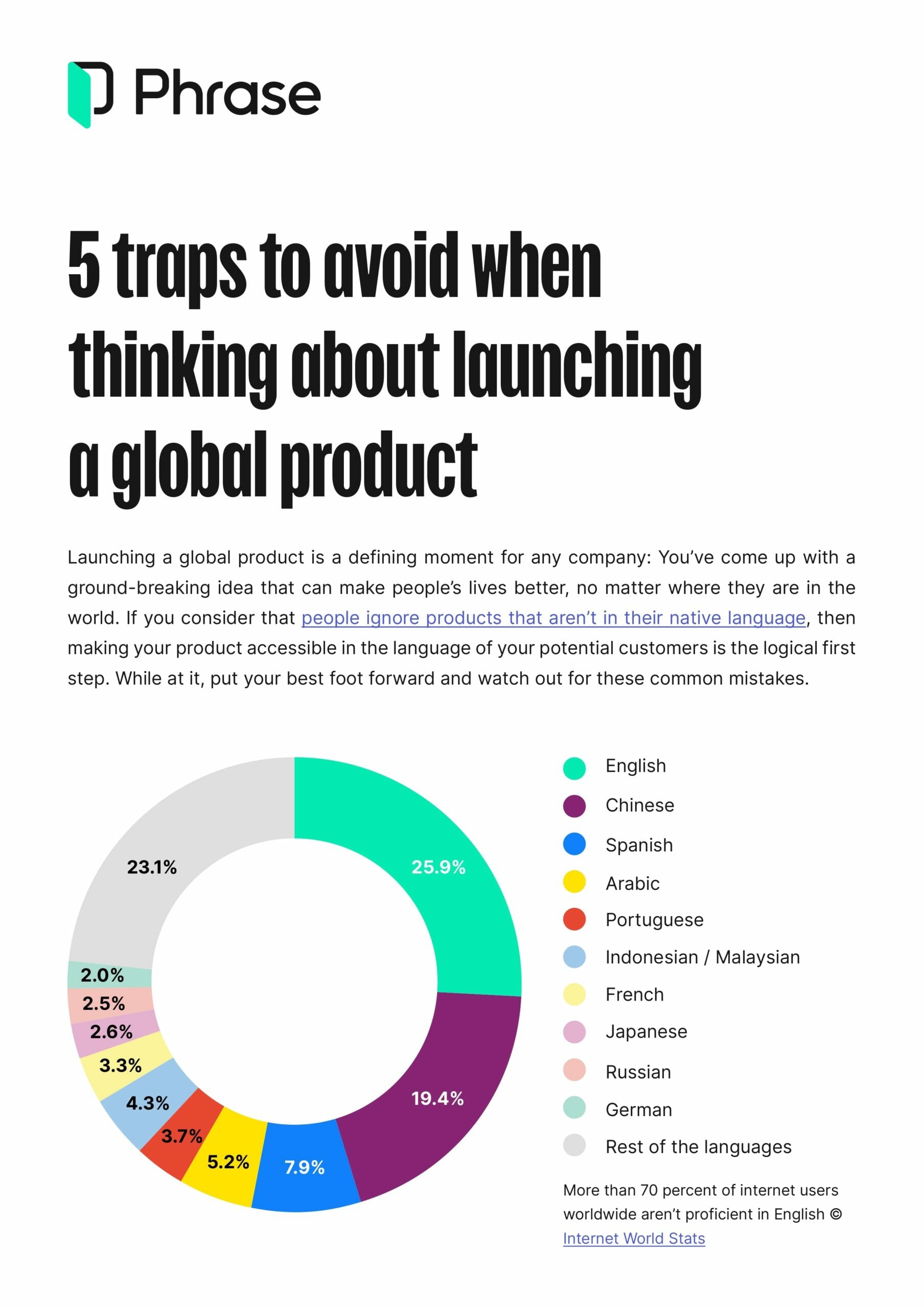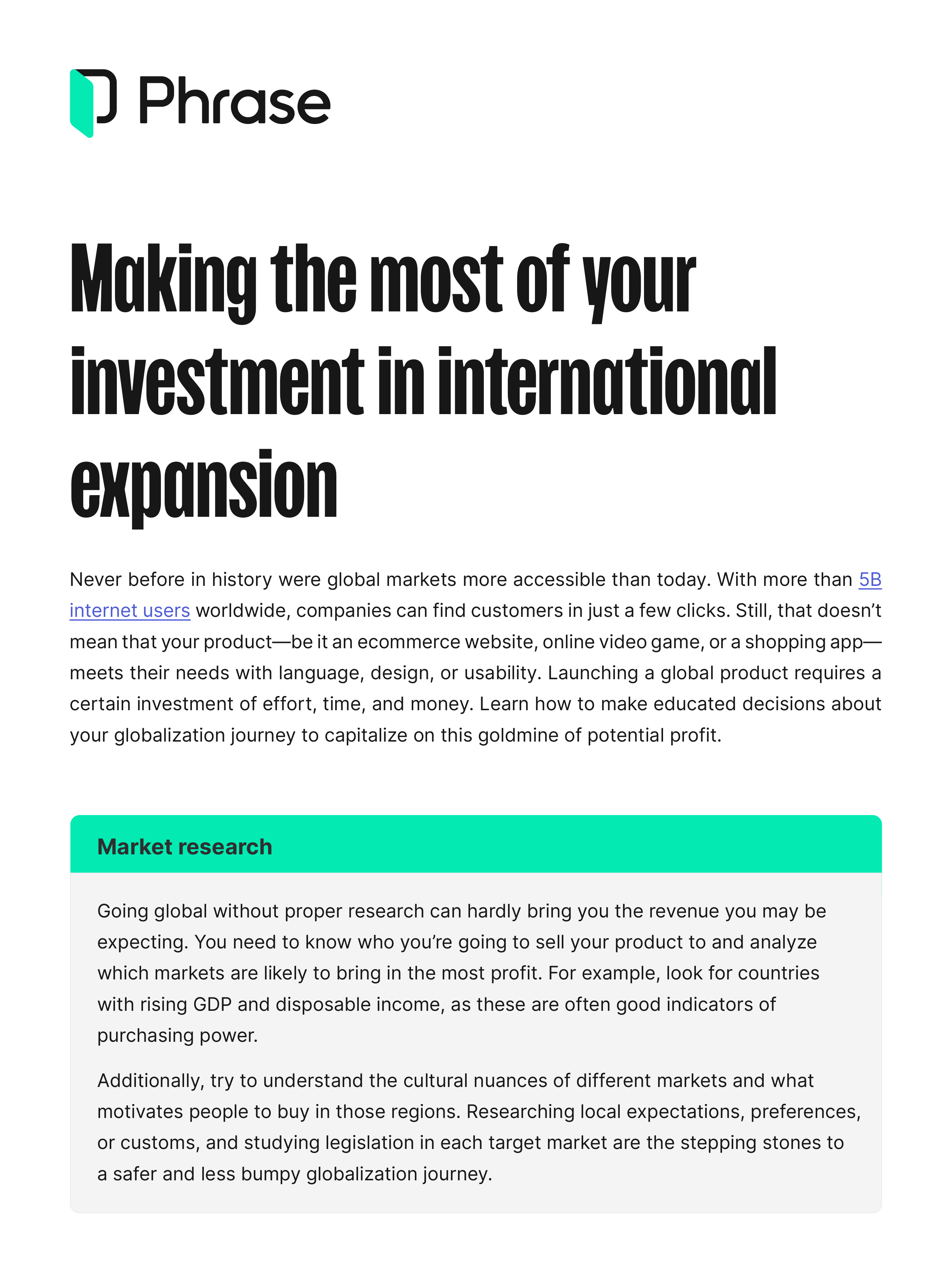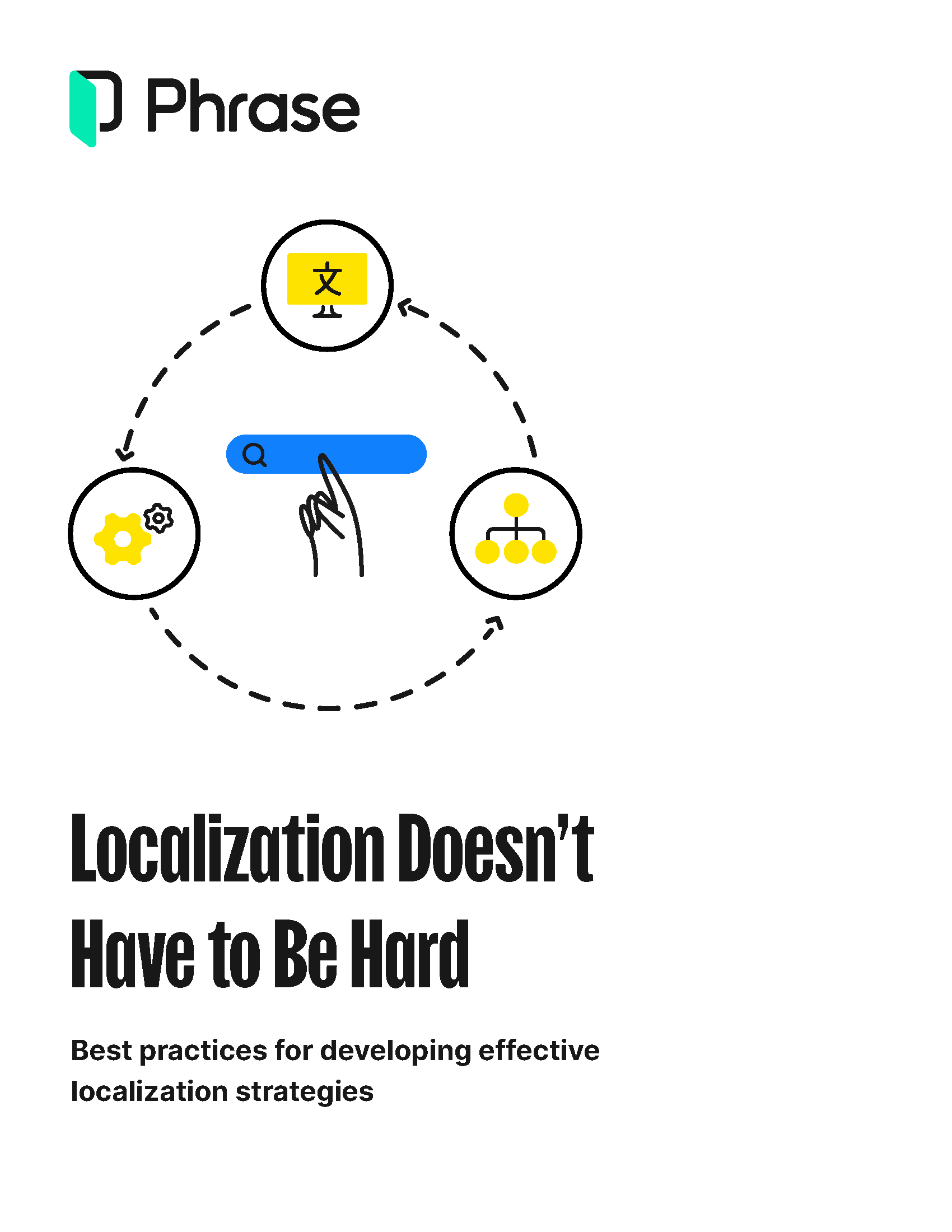Global business
Global Standardization Strategy: Navigating Uniformity and Variation for Business Growth

From New York and London to Mumbai and Tokyo, global expansion is at the forefront of CEO agendas worldwide: 72% of global businesses are planning major investments to support ambitious expansion plans.
However, maintaining global growth presents the challenge of ensuring brand consistency and operational efficiency. To address this, businesses embrace global standardization—a strategy that aims for uniformity in products and business operations across markets.
This guide explores how to navigate the complexities and challenges of standardization in a global context—from understanding the benefits and realizing the limitations to defining objectives and measuring effectiveness.
What is global standardization?
In a business context, global standardization refers to the process of developing and applying uniform standards across multiple markets. The aim is ensuring consistency, quality, and interoperability of products, services, or processes.
Standardization can occur in various aspects of business such as product design, manufacturing processes, quality assurance, and marketing strategies.

FREE DOWNLOAD
5 traps to avoid when thinking about launching a global product
Most people ignore products in languages that they don’t speak, so give yourself the best chance of success by avoiding these 5 common mistakes in global expansion.
Pros and cons of global standardization
As more businesses set their sights on global expansion, a global standardization strategy serves as a double-edged sword, offering both compelling advantages and inherent limitations.
On one hand, it paves the way for economies of scale, simplified operations, and a unified brand image that resonates universally.
On the other hand, it risks overlooking the unique nuances of local markets—ranging from consumer preferences to regulatory frameworks—potentially leading to missed opportunities and challenges in adaptation.
Understanding these trade-offs is crucial for businesses aiming to make a global impact while maintaining a competitive edge.
Benefits of global standardization
When does a global standardization strategy make most sense? Companies with a broad international presence—or those aspiring to one—stand to benefit the most from a global standardization strategy.
Industries such as technology, fast-moving consumer goods, and automotive sectors, where products and services are universally used and have limited local variations, are particularly well-suited for standardization.
By implementing a coherent and unified approach across multiple markets, businesses can gain numerous advantages ranging from operational efficiencies to brand consistency. Here, we delve into some of the most significant benefits of employing a global standardization strategy.
Economies of scale
One of the most compelling reasons to standardize globally is the opportunity for economies of scale. Producing large volumes of a standardized product can lower the cost per unit. This advantage not only aids in achieving competitive pricing but also provides the leeway for increased investment in other areas, such as research and development or marketing.
For example, a large business, such as a car manufacturer, can produce a big quantity of the same parts using a global supply chain and integrate these inputs into a small range of products.
On a per-item basis, costs drop significantly and enable the car company to sell finished vehicles at a much lower cost to the end consumer. With better pricing, the manufacturer can gain market share and strengthen profitability.
Consistent brand image
A standardized approach allows for a cohesive brand image across different markets. With a higher level of global brand consistency, recognition is enhanced and brands build customer trust, thereby making it easier for the company to enter new markets.
Consistency in branding elements like logos, taglines, and even the customer experience can lead to a stronger global brand equity.
Food brands are one industry where consistent brand image is very beneficial. Consumers can rely on buying the same brand and repeatedly getting a high-quality product–in turn, the food company develops a strong reputation and wins loyal customers.
Simplified operations
Managing operations becomes more straightforward with standardization. Whether it’s product specifications, supplier contracts, or internal processes, having a uniform approach eliminates the complexities of managing multiple variations.
This simplification not only streamlines decision-making but also aids in quicker, more effective execution of strategies.
For example, during the COVID-19 pandemic, fast and safe vaccine and medicine production were essential to global health efforts. Very standardized processes are an important part of how pharmaceutical operations run, keeping production levels high and enabling factories to meet the demand quickly.
Given the inherent complexity already involved in pharmaceutical work, keeping operations as simplified as possible helps improve efficiency.
Greater control
Standardization offers a centralized approach to business management, enabling greater control over various operational aspects. It ensures that best practices are uniformly implemented across all units and makes it easier to maintain quality standards.
Centralized control can also be beneficial for quicker decision-making and implementation of changes at a global level.
A standardized approach to quality can make it easier to maintain consistent quality levels across different markets. Many companies get ISO 9001 certified for quality management, which is recognized globally.
In some industries, such as computer chip manufacturing, there is very little room for error and product uniformity is important. Sensitive electronics must meet specific technological specifications and production occurs according to very nuanced processes.
Standardized production allows the manufacturer to uniformly make computer chips that meet the right specifications more quickly and at a lower cost.
Cost savings
Last but not least, cost savings are a significant benefit of global standardization. By eliminating the need for multiple product versions or marketing strategies, companies can substantially reduce costs.
Moreover, centralized operations can lead to lower overhead costs and create savings that can be reinvested back into the business.
Packaging is one example of cost savings through standardization. Corrugated cardboard boxes are relatively similar to each other—by design.
Quantity discounts, less frequent changes to equipment, logistics and handling reductions, and other efficiencies allow for better usage of cardboard boxes at a much lower cost.

Dive deeper
Making the most of your investment in international expansion
Find out how best to connect with customers worldwide and where to focus your money and efforts to ensure that you get the best ROI when going global.
Limitations of global standardization
While global standardization comes with many benefits, it’s important to recognize that it also has its drawbacks. Industries that rely heavily on cultural nuances, such as food and beverage or fashion, may find standardization particularly challenging.
A standardization strategy is used when a global company benefits much more from fewer product variations—in some idustries, this simply isn’t the case.
Even tech giants and global consumer brands must tread carefully to avoid pitfalls. The limitations can range from cultural insensitivity to regulatory challenges—and understanding these can help businesses craft a more effective and adaptable standardization strategy.
These are some of the key limitations to consider:
Cultural sensitivity
One of the most significant limitations is the risk of overlooking local customs, values, or consumer needs. Standardization often assumes that what works in one market will work in another—which might not always be the case.
Ignoring cultural sensitivities can result in negative customer experiences and potential backlash, affecting brand reputation.
Limited adaptation
Standardization can reduce a company’s ability to adapt quickly to market changes or to the needs of different customer segments. It’s by definition almost impossible for an organization to adapt to local market conditions when it adheres to standardization.
This rigidity may result in missed opportunities and hamper the business’s competitiveness in individual markets.
Regulatory changes
Global standardization can also make a business more vulnerable to regulatory changes. Since it often relies on a centralized strategy, any regulatory shift in a significant market can necessitate changes that affect the entire global operation. This vulnerability can lead to unexpected costs and disruptions.
Competitive pressure
Companies adopting a global standardization strategy may face intense competition from local businesses that are more attuned to the needs of the domestic market.
Local competitors often have the flexibility to adapt quickly to market trends and changes, putting standardized global businesses at a competitive disadvantage.
Generic user experience
A standardized approach often leads to a uniform user experience, which may not be appealing to all customers. In striving for consistency, businesses may overlook the unique experiences that make a product or service more attractive in specific markets.
This limitation can result in a less engaging customer experience, impacting customer loyalty and retention.
While global standardization offers a host of benefits, it’s not without limitations that can affect a company’s success in various markets. Awareness of these challenges is the first step in creating a more nuanced and adaptable global strategy to meet the diverse needs of a global customer base.
Standardization vs localization: Striking the right balance
When navigating the complexities of multiple markets simultaneously, businesses often have the choice between 2 contrasting approaches to seize global opportunities: standardization and localization.
Although both concepts can occasionally merge into a hybrid “glocal” strategy, it’s crucial to understand that they differ fundamentally in several key ways.
That’s why global standardization strategy advantages and disadvantages are worth reviewing and pondering to help you decide on the right outlook for your business.
Overcoming standardization challenges in global business with localization
While global standardization is an attractive strategy for its efficiencies and uniformities, it’s not without its challenges.
A strategic approach to overcoming standardization obstacles often lies in the art of localization—an adaptable methodology that melds the best of both worlds.
Incorporating localization tactics as a complementary approach can let companies enjoy the benefits of standardization while effectively addressing its inherent limitations.
Here’s how localization can help businesses navigate the complex waters of global standardization challenges.
On-demand webinar
Localization: Why you need it, and how to start
Learn from our expert panel how to prepare for global expansion, overcome common localization obstacles, and drive international growth.
Cultural relevance and market adaptation
One of the biggest drawbacks of a one-size-fits-all approach is the risk of cultural irrelevance. Localization allows businesses to adapt their products, services, and messaging to reflect local tastes, beliefs, and traditions.
This cultural sensitivity allows brands to truly resonate with target audiences in different local markets.
Local or regional regulatory compliance
Global standardization often stumbles upon the varied and complex regulatory landscapes of different markets. Through localization, companies can modify specific aspects of their products or services to comply with local laws and regulations—reducing the risk of legal issues and fostering better relationships with local authorities.
Faster time to market and competitive edge
Localization can speed up the time to market in new regions. Since the products or services are tailored to meet local needs and regulatory frameworks, businesses can often bypass the lengthy modification processes that a strictly standardized approach would require.
As a result of this speed to market, a company is able to establish a presence before its competitors.
Improved user experience and competitive edge
Localized products or services tend to offer a more intuitive and comfortable experience for local users. Whether it’s an app interface in the local language or a product adapted to local use cases, these changes can greatly improve user experience.
A localized user experience can set a brand apart from competitors who offer only standardized options.
Improved user experience and customer loyalty
Beyond providing an initial competitive edge, localization also has long-term benefits. When customers see that a brand has invested in understanding and catering to their specific needs, it often fosters loyalty.
A localized user experience that meets or exceeds customer expectations is a potent tool for retaining customers over time.
Increased sales and revenue
Ultimately, the aim of any business strategy is to impact the bottom line positively. Localization can significantly contribute to this by enhancing market penetration and customer engagement.
Satisfying local needs and preferences often leads to increased sales, repeat business, and consequently, higher revenue.

Free download
Best practices for developing effective localization strategies
Explore how to tackle localization management efficiently and engage customers across the globe in their native languages and local experiences.
How to create a global standardization strategy?
Embarking on the journey towards a global standardization strategy in international business requires meticulous planning, cross-disciplinary collaboration, and a continuous improvement mindset.
From defining your goals and aligning with international regulations to optimizing stakeholder management, every step serves as a critical milestone.
The following are some core aspects you should consider when formulating a global standardization strategy for your business.
Define specific objectives and scope
Every successful global standardization strategy spells out specific objectives and the scope of the standardization.
Whether it’s achieving cost efficiency, enhancing product quality, or simplifying supply chain management—having clear goals ensures that all actions are aligned with the overarching business vision.
The scope should delineate which products, services, or processes are to be standardized and in which geographical markets.
Conduct comprehensive market research
Understanding your market is critical for standardization. Conduct thorough market research to gather insights on customer behavior, preferences, and needs across different global markets. Investigate competitors’ strategies and assess their success or failure in standardizing their offerings.
Market research will provide invaluable data for making informed decisions.
Identify and align with regulatory frameworks
Different markets have varying regulations governing product standards, quality, and safety. Identify these regulatory frameworks and ensure that your standardization strategy aligns with them.
Failure to comply can result in fines, bans, or other regulatory actions that could significantly impact business operations.
Form dedicated cross-functional teams
Creating a dedicated cross-functional team ensures that all aspects of the business are considered when implementing a global standardization strategy.
You can achieve a unified approach by bringing together marketing, manufacturing, logistics, and legal departments.
Create streamlined processes and protocols
Standardized procedures and protocols are the backbone of any standardization strategy. Document best practices, develop guidelines, and create standard operating procedures that can be implemented consistently across different regions. Streamlined processes contribute to operational efficiency and quality control.
Embrace adaptability and flexibility
While the essence of standardization is uniformity, it’s essential to build some level of adaptability and flexibility into your strategy. Market conditions and customer preferences can change, and regulatory requirements may be updated.
An effective standardization strategy should be agile enough to adapt to these changes.
Establish effective communication channels
Effective communication across all levels of the organization is vital for the successful implementation of a global standardization strategy.
Whether it’s internal communication among team members or external communication with suppliers and stakeholders, transparent and open channels will ensure that everyone is on the same page.
Continuously monitor and evaluate performance
The work doesn’t end once a standardization strategy is rolled out. Continuous monitoring and evaluation are crucial for measuring the strategy’s success against the defined objectives.
Make sure you define clearly measurable key performance indicators (KPIs) and track specific metrics to assess effectiveness and identify areas for improvement. More on that below.
Seek stakeholder engagement and input
Engaging with stakeholders, including employees, suppliers, partners, and even customers, can provide valuable insights and foster a sense of ownership and collaboration.
Their input can be instrumental in refining the standardization strategy and making it more effective.
Iterate and refine your strategy as needed
The global market is dynamic, and a “set-it-and-forget-it” approach will hardly be enough. Regularly revisit and, if necessary, revise your standardization strategy based on performance metrics, stakeholder feedback, and changing market conditions.
Iterative refinement will keep your strategy aligned with business objectives and market realities.
Measuring the effectiveness of a global standardization strategy
Effectively implementing a global standardization strategy is only half the battle—the other half lies in robust evaluation to gauge its success and identify areas for improvement.
Evaluating standardization efforts
Regularly tracking performance through specific metrics will offer you insights into your standardization strategy’s impact, scalability, and alignment with overall business goals.
This ongoing evaluation is crucial for making informed decisions, adapting to market changes, and ensuring that the strategy aligns with long-term business objectives.
| Key metrics to evaluate the effectiveness of global standardization | |
| Cost efficiency metrics | One of the primary goals of standardization is to achieve cost savings. Monitor metrics like cost per unit, production costs, and supply chain costs to understand how standardization is affecting the bottom line. |
| Quality metrics | Quality control is often easier to manage under a standardization strategy. Metrics such as defect rates, customer returns, and quality scores can offer insights into how well the standardization is working in terms of product or service quality. |
| Market penetration and market share | Track market penetration rates and market share to determine how effective your standardized approach is in capturing new markets or retaining existing ones. |
| Customer satisfaction scores | While a standardized offering may not cater to local preferences, customer satisfaction should still remain high if the strategy is effective. Customer feedback, net promoter scores (NPS), and customer satisfaction surveys can provide valuable information. |
| Regulatory compliance metrics | Track incidents of regulatory violations, fines, or sanctions as indicators of how well the standardization strategy aligns with local, regional, and international laws. |
| Time to market | Measure the speed at which new products or updates are launched across various markets. Standardization should ideally reduce the time to market due to reduced complexity. |
| Employee productivity and engagement | Standardized processes can also affect your workforce. Monitor productivity rates and use employee engagement surveys to understand how standardization impacts internal stakeholders. |
| Revenue and profit margins | Ultimately, the effectiveness of a global standardization strategy can be gauged by its impact on revenue and profit margins. Compare these financial metrics before and after the implementation of the standardization strategy to assess its success. |
| Customer retention rates | High customer retention rates can signal that the standardized products or services are meeting customer expectations consistently across markets. |
| Competitive benchmarking | Compare your KPIs and metrics with industry standards or competitors who are also employing a global standardization strategy. This can offer an external perspective on the effectiveness of your efforts. |
Examples of global standardization strategy to learn from
Taking a closer look at the companies that implement global standardization strategies reveals a number of industry leaders who use standardization in their operations and supply chains to become more competitive.
These examples offer valuable lessons for businesses looking to implement or refine their own standardization approaches.
Apple’s global standardization strategy
Apple Inc. is an exemplary case of a company that has successfully employed a global standardization strategy. The tech giant offers a consistent product line across the world, ranging from iPhones to MacBooks.
This approach not only streamlines manufacturing but also simplifies marketing efforts. Apple focuses on high-quality, user-friendly design and innovation, elements that are universally appreciated, thus reducing the need for localized products.
However, it’s worth noting that Apple does make subtle adaptations for local markets where necessary, such as complying with local laws or offering region-specific payment methods, without compromising the core aspects of its products or brand.
Key takeaways from Apple:
- Uniform product offerings across different markets
- High focus on quality and innovation, attributes that have universal appeal
- Strategic minor adaptations to meet local needs or regulations
Coca-Cola’s global standardization strategy
Coca-Cola is another example of a brand that has skillfully leveraged global standardization to build a ubiquitous presence. The company’s core product, Coca-Cola soda, remains largely the same regardless of where it is sold, which has helped build a universally recognized brand.
Coca-Cola also employs a level of localization by offering variations in flavor or formulation to suit specific market preferences, such as kosher versions for Jewish communities or specific flavors in certain markets, however.
The standardization strategy, in this case, extends beyond the product to advertising and brand messaging, creating a cohesive brand image worldwide.
Key takeaways from Coca-Cola:
- Consistent core product to build a strong, global brand
- Use of localized versions to cater to specific market needs without deviating from the core product
- Unified marketing and branding across regions
IKEA’s global standardization strategy
IKEA, the Swedish home furnishings retailer, has adopted a unique blend of standardization and localization. While the company offers a largely consistent product range across different markets, its global standardization strategy is most evident in its business operations.
IKEA uses a standardized supply chain, sourcing its materials globally to maintain quality while achieving economies of scale. The store layouts, too, are almost universally similar, providing a consistent customer experience.
However, IKEA is mindful of local tastes and adjusts its product offerings or store setups to accommodate cultural differences, such as varying bed sizes or kitchen setups in different markets.
Key takeaways from IKEA:
- Standardized operations and supply chain for economies of scale
- Consistent customer experience through similar store layouts
- Adaptive to cultural preferences without compromising on the standardized aspects of the business
These case studies illuminate how global standardization can be effectively implemented while allowing room for localization where needed. They demonstrate that a well-executed standardization strategy can drive efficiencies, create a unified brand image, and still be adaptable to local market conditions.
Scale with a global standardization strategy
Scaling your business through a global standardization strategy offers a pathway to operational efficiency, brand uniformity, and cost-effective growth. By harmonizing products, services, and processes across international markets, companies can achieve significant economies of scale and carve out a strong, recognizable global presence.
However, it’s crucial to strike a delicate balance between standardization and localization to navigate the diverse regulatory and cultural landscapes effectively. As illustrated by industry giants like Apple, Coca-Cola, and IKEA, a well-executed standardization strategy can be both adaptable and powerful, enabling your business to scale sustainably in an increasingly interconnected world.




